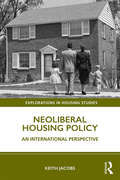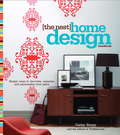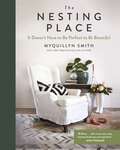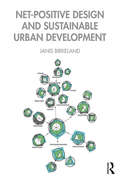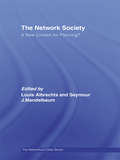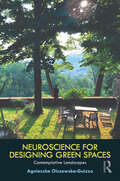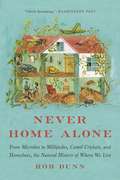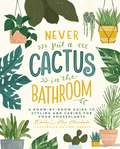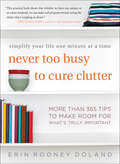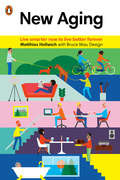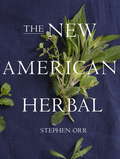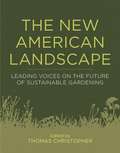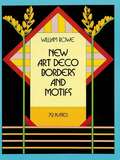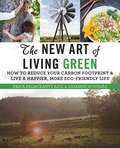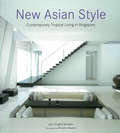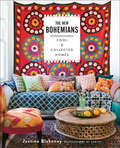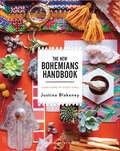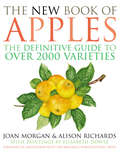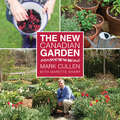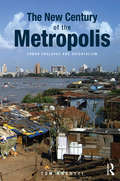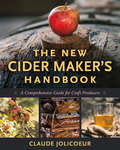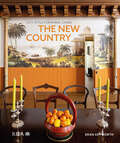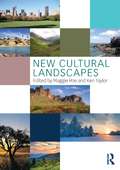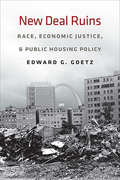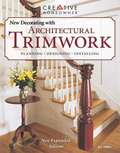- Table View
- List View
Neoliberal Housing Policy: An International Perspective (Explorations in Housing Studies)
by Keith JacobsNeoliberal Housing Policy considers some of the most significant housing issues facing the West today, including the increasing commodification of housing; the political economy surrounding homeownership; the role of public housing; the problem of homelessness; the ways that housing accentuates social and economic inequality; and how suburban housing has transformed city life. The empirical focus of the book draws mainly from the US, UK and Australia, with examples to illustrate some of the most important features and trajectories of late capitalism, including the commodification of welfare provision and financialisation, while the examples from other nations serve to highlight the influence of housing policy on more regional- and place-specific processes. The book shows that developments in housing provision are being shaped by global financial markets and the circuits of capital that transcend the borders of nation states. Whilst considerable differences within nation states exist, many government interventions to improve housing often fall short. Adopting a structuralist approach, the book provides a critical account of the way housing policy accentuates social and economic inequalities and identifies some of the significant convergences in policy across nations states, ultimately offering an explanation as to why so many ‘inequalities’ endure. It will be useful for anyone in professional housing management/social housing programmes as well as planning, sociology (social policy), human geography, urban studies and housing studies programmes.
The Nest Home Design Handbook
by Carley RoneyDecorating for the first time can be completely overwhelming. How do you find your style? How do you keep expenses under control? What essential pieces does every home need for maximum functionality and flair? How will you merge tastes--and stuff--to create a space that feels like home to you both? Here to take the guesswork out of decorating is The Nest Home Design Handbook, a practical, gorgeous, room-by-room guide to giving your place unique and affordable style.Learn how to: -Design with your inner stylist in mind-Arrange your living room-Mix modern pieces and Mom's hand-me-downs-Choose the right paint colors-Freshen a formal kitchen space-Make a small space look bigger-Hang pictures properly-Jazz up your walls-Buy good furniture (on a budget)-Kill the clutterPLUS: Suggestions for displaying your stuff in fun and interesting ways, DIY wall art ideas, tips for organizing every room, information on basic home repairs, and more!
The Nesting Place: It Doesn’t Have to Be Perfect to Be Beautiful
by Myquillyn SmithPerfection is overrated. Popular blogger and self-taught decorator Myquillyn Smith (The Nester) is all about embracing reality—especially when it comes to decorating a home bursting with boys, pets, and all the unpredictable messes of life.In The Nesting Place, Myquillyn shares the secrets of decorating for real people—and it has nothing to do with creating a flawless look to wow your guests. It has everything to do with embracing the natural imperfection and chaos of daily living.Drawing on her years of experience creating beauty in her 13 different homes, Myquillyn will show you how to think differently about the true purpose of your home and simply and creatively tailor it to reflect you and your unique style—without breaking the bank or stressing over comparisons. Full of easy tips, simple steps, and practical advice, The Nesting Place will give you the courage to take risks with your home and transform it into a place that’s inviting and warm for family and friends.There is beauty in the lived-in and loved-on and just-about-used-up, Myquillyn says, and welcoming that imperfection wholeheartedly just might be the most freeing thing you’ll ever do.
Net-Positive Design and Sustainable Urban Development
by Janis Birkeland‘Sustainable’ urban planning, policy and design professes to solve sustainability problems, but often depletes and degrades ever more resources and ecosystems and concentrates wealth and concretize social disparities. Positive Development theory holds that development could create more net ecological and social gains than no construction at all. It explains how existing conceptual, physical and institutional structures are inherently biased against the preservation and expansion of social and natural life-support systems, and proposes explicit reforms to planning, design and decision making that would enable development to increase future options and social and natural life-support systems – in absolute terms. Net-Positive Design and Sustainable Urban Development is aimed at students, academics, professionals and sustainability advocates who wonder why existing approaches have been ineffective. It explains how to reform the anti-ecological biases in our current frameworks of environmental governance, planning, decision making and design – and suggests how to make these changes. Cities can increase both the ‘public estate’ (reduce social stratification, inequity and other causes of conflict, increase environmental quality, wellbeing and access to basic needs, etc.); and the ‘ecological base’ (sequester more carbon and produce more energy than used during construction and operation, increase ecological space to support ecological carrying capacity, ecosystem functions and services, restore the bioregions and wilderness, etc.). No small task, this new book provides academic theory and professional tools for saving the planet, including a free computer app for net-positive design.
The Network Society: A New Context for Planning (Networked Cities Series)
by Louis Albrechts Seymour J. MandelbaumIn a clear and rewarding style, Albrechts and Mandelbaum consider the challenges that the new paradigm of the Network Society creates for Urban and Regional Planning. Chapters grouped into five themes discuss theoretical and practical perspectives on the contemporary organization of social, economic, cultural, political and physical spaces. These sections are: models of the Network Society the impact of physical networks such as transport challenges for Planners raised by society’s increased reliance on new technology an examination of local networks including community networks and the possibilities of setting up local networks for disaster recovery a comparison of spatial and policy networks and an exploration of the institutions involved. This book is essential reading for graduate level courses in urban studies, city and regional planning, and urban design. With its clear structure – unitary sections but a diversity of perspectives – the book can be used easily in courses such as Planning Theory, Urban Infrastructure and Public Policy.
Neuroscience for Designing Green Spaces: Contemplative Landscapes
by Agnieszka Olszewska-GuizzoUrban parks and gardens are where people go to reconnect with nature and destress. But do they all provide the same benefits or are some better than others? What specific attributes set some green spaces apart? Can we objectively measure their impact on mental health and well-being? If so, how do we use this evidence to guide the design of mentally healthy cities? The Contemplative Landscape Model unveils the path to answer these questions. Rooted in landscape architecture and neuroscience, this innovative concept is described for the first time in an extended format, offering a deep dive into contemplative design and the science behind it. In the face of the global mental health crisis, and increasing disconnection from nature, design strategies for creating healthier urban environments are what our cities so sorely need. This book delves into the neuroscience behind contemplative landscapes, their key spatial characteristics, and practical applications of the Contemplative Landscape Model through case studies from around the world. Landscape architects, urban planners, students, land managers, and anyone interested in unlocking the healing power of landscapes will find inspiration here.
Never Home Alone: From Microbes to Millipedes, Camel Crickets, and Honeybees, the Natural History of Where We Live
by Rob DunnA natural history of the wilderness in our homes, from the microbes in our showers to the crickets in our basements <P><P>Even when the floors are sparkling clean and the house seems silent, our domestic domain is wild beyond imagination. In Never Home Alone, biologist Rob Dunn introduces us to the nearly 200,000 species living with us in our own homes, from the Egyptian meal moths in our cupboards and camel crickets in our basements to the lactobacillus lounging on our kitchen counters. You are not alone. <P><P>Yet, as we obsess over sterilizing our homes and separating our spaces from nature, we are unwittingly cultivating an entirely new playground for evolution. These changes are reshaping the organisms that live with us--prompting some to become more dangerous, while undermining those species that benefit our bodies or help us keep more threatening organisms at bay. <P><P>No one who reads this engrossing, revelatory book will look at their homes in the same way again.
Never Put a Cactus in the Bathroom: A Room-by-Room Guide to Styling and Caring for Your Houseplants
by Emily L. HinsdaleFuel your houseplant obsession with this beautifully illustrated room-by-room guide to bringing the outdoors inside—perfect for plant parents everywhere!Millions of plant lovers and newbie gardeners are discovering the joys of bringing plants into their homes. Not only do they add a fresh, natural touch to any room, they also have serious mood-boosting power, and help to reduce stress, improve air quality, and even provide fresh herbs for that next meal! It&’s a no-brainer that houseplants can improve our quality of life—but how do you maximize their benefits without sacrificing style. Full of home design and practical plant care tips as well as more than 70 plant recommendations, Never Put a Cactus in the Bathroom is an illustrated guide to help you choose the right plants for your space, from succulents and spider plants to pothos and ZZ plants. A Houseplant 101 section will set you off on the right foot, covering essentials of plant care and maintenance, as well as basic troubleshooting, and a primer on the health benefits of indoor plants. Then, going room by room, you will find space-specific recommendations, such as: -Purifying the air in your bedroom with low light beauties -Decorating your bathroom with air plants and ferns—your shower powers the climate is they need to thrive! -Creating a living centerpiece for your dining room or breakfast nook -Adding a low-maintenance bamboo or jade plant to your home office for motivation and focus -Growing a windowsill herb box or hydroponic tomato to level up your next meal Perfect for fans of Wild at Home, Urban Jungle, and Wellness by Design, this book will give plant lovers the tools and confidence they need to bring houseplants into every corner of their homes, improve their quality of life, and turn their home into a natural sanctuary.
Never Too Busy to Cure Clutter: Simplify Your Life One Minute at a Time
by Erin Rooney DolandALL THE ADVICE AND MOTIVATION YOU NEED TO KICK-START YOUR HOME ORGANIZING PROJECT . . . ON YOUR SCHEDULEWhether you have thirty seconds, one minute, five minutes, or fifteen minutes, this organizing daily devotional offers tips, checklists, weekend projects, quizzes, and encouragement that will help you find the time, motivation, and permission to let go of sentimental clutter, set up storage solutions, and establish routines that make sense for your life.Filled with practical advice and small, doable projects that were created with your busy life in mind, Never Too Busy to Cure Clutter is a loyal resource, as well as a workbook, that you can rely on for straightforward, inspiring advice and tips you can return to time and time again.Yes, you’re busy, but you’re never too busy to cure clutter.
New Aging: Live Smarter Now to Live Better Forever
by Matthias Hollwich Bruce Mau DesignAging is a gift that we receive with life--and in New Aging, the architect Matthias Hollwich outlines smart, simple ideas to help us experience it that way. New Aging invites us to take everything we associate with aging--the loss of freedom and vitality, the cold and sterile nursing homes, the boredom--and throw it out the window. As an architect, Matthias Hollwich is devoted to finding ways in which we can shape our living spaces and communities to make aging a graceful and fulfilling aspect of our lives. Now he has distilled his research into a collection of simple, visionary principles--brought to life with bright, colorful illustrations--that will inspire you to think creatively about how you can change your habits and environments to suit your evolving needs as you age. With advice ranging from practical design tips for making your home safer and more comfortable to thought-provoking ideas on how we work, relax, and interact with our neighbors, and even how we eat, New Aging will inspire you and your loved ones to live smarter today so you can live better tomorrow.From the Trade Paperback edition.
The New American Herbal
by Stephen OrrFrom modern garden master Stephen Orr comes a new, definitive book on herbs to finally replace the dusty and outdated classics. Here are entries on hundreds of plants that are extraordinarily useful in cooking, homeopathy, and more; dozens of recipes and DIY projects; and beautifully styled photographs so you know just what you're growing.With more than 900 entries, each accompanied by brand new photography and helpful growing advice, The New American Herbal takes the study of herbs to an exciting new level. Orr covers the entire spectrum of herbaceous plants, from culinary to ornamental to aromatic and medicinal, presenting them in an easy to use A to Z format packed with recipes, DIY projects, and stunning examples of garden design highlighting herbal plantings. Learn about the herbs you've always wanted to grow (chervil, chamomile, and lovage), exotic herbs (such as Artemisia, the bitter herb used in Absinthe, or the anti-inflammatory Meadowsweet), and ornamental varieties (Monkshood and Perilla). For cooks there is indispensable guidance on planting and maintaining a bountiful kitchen garden and crafters will delight in dozens of exciting new uses for fresh, dried, and distilled herbs. Here, too, are 40 delicious recipes such as Ragu Bolognese with Fennel and Lemon Semolina Cake with Lavender, as well easy steps for projects such as a hanging herb garden and instructions on how to plant, dry, and preserve your garden's bounty. Meticulously researched and exhaustive in its scope, The New American Herbal is an irresistible invitation to explore the versatility of herbs in all their beauty and variety.From the Trade Paperback edition.
The New American Landscape: Leading Voices on the Future of Sustainable Gardening
by Thomas ChristopherGardeners are the front line of defense in our struggle to tackle the problems of global warming, loss of habitat, water shortages, and shrinking biodiversity. In The New American Landscape, author and editor Thomas Christopher brings together the best thinkers on the topic of gardening sustainably, and asks them to describe the future of the sustainable landscape. The discussion unfolds from there, and what results is a collective vision as eloquent as it is diverse.The New American Landscape offers designers a roadmap to a beautiful garden that improves, not degrades the environment. It’s a provocative manifesto about the important role gardens play in creating a more sustainable future that no professional garden designer can afford to miss. John Greenlee and Neil Diboll on the new American meadow gardenRick Darke on balancing natives and exotics in the gardenDoug Tallamy on landscapes that welcome wildlifeEric Toensmeier on the sustainable edible gardenDavid Wolfe on gardening sustainable with a changing climateElaine Ingham on managing soil healthDavid Deardorff and Kathryn Wadsworth on sustainable pest solutionsEd Snodgrass and Linda McIntyre on green roofs in the sustainable residential landscapeThomas Christopher on waterwise gardensToby Hemenway on whole system garden designThe Sustainable Site Initiative on the managing the home landscape as a sustainable site
New Art Deco Borders and Motifs (Dover Pictorial Archive)
by William RoweThis collection of 72 full-page black-and-white Art Deco designs offers artists and craftspeople royalty-free, ready-to-use borders, frames, and motifs. Abstract geometric forms contrast with foliate and floral elements in dynamic designs. Useful in graphic arts, textile and upholstery design and more.
The New Art of Living Green: How to Reduce Your Carbon Footprint and Live a Happier, More Eco-Friendly Life
by Erica Palmcrantz Aziz Susanne HovenäsIn today's busy world it's easy to understand the desire for shortcuts. With our time eaten up by work, family, and errands, we almost unconsciously look for quick fixes that aren't always the healthiest for our home or family. With The New Art of Living Green, authors Erica Palmcrantz Aziz and Susanne Hovenäs dare us to stop and think for a moment about the type of chemicals we use in our home, where we buy our produce, and the amount of waste we create. With this book you'll discover simple tips and guidelines that will help you to make greener choices to the benefit of your growing family's health and a grateful Mother Earth.This guide provides a collection of proven ways to live green practically, and on a daily basis. The book is divided into seven chapters, each represented by a color of the rainbow. Learn more about such topics as: The World around You: How to act now The Home: Making slow and simple changes The Body: Going from chemicals to natural The Garden:How to farm anywhere Work and Play: Incorporating sustainable living into your routine Raw Food: Green recipes for you and Mother Earth Spirituality: Discovering the feeling of togethernessIt's easy to become complacent with a routine, so to help free you of bad habits, each chapter ends with seven challenges for you to try at home. Finally transform thought into action and lend a helping hand toward making our planet a better place for future generations to come. Even the smallest of changes can make a difference!
New Asian Style
by Masano Kawana Jane Doughty MarsdenMore than ever before, interior design is a global affair. And more than ever, Westerners are eager to try out elements of Asian design. This book is the ultimate resource for professional and amateur designers seeking to recreate the mysterious elegance, balance, and beauty of Asian design. Through the magic of Masano Kawana's beautiful full-color photography, New Asian Style explores more than 30 stunning contemporary houses and homes from Singapore, all of which stand as examples of decorating and style that transcend their Eastern origins. In an effort to help designers pick up Asian ideas for their own settings, Jane Marsden's essays examine what elements make Asian style and how they might be captured in new settings anywhere in the world.
The New Bohemians: Cool & Collected Homes
by Justina BlakeneyA New York Times bestseller. “With pages of tips and twelve DIY projects, the book makes the free-spirited style easy to achieve.” —Architectural DigestIn The New Bohemians, LA-based designer Justina Blakeney defines the New Bohemians as creative individuals who are boutique owners and bloggers, entrepreneurs and ex-pats, artists and urban farmers.They embrace free-spirited, no-rules lifestyles and apply that attitude to all areas of their existence, including their homes. With little distinction between work and play, the new boho home often includes an office, art gallery, showroom, photography studio, restaurant, or even a pop-up shop. The New Bohemians explores 20 homes located primarily on the East and West coasts. Exclusive interviews with the owners, 12 DIY projects created by Blakeney and inspired by objects found in the homes, and a “Plant-O-Pedia” offer insight into achieving this aesthetic. In addition, each home is accompanied by an Adopt-an-Idea section that offers general decor, styling, and shopping tips for easy duplication in your own home.“The New Bohemians is sure to inspire readers to create, to reuse, to grow, to let loose, and to invite some cool and collected energy into their own homes.” —California Home+Design “A colorful and endlessly inspiring cover-to-cover read . . . From the dreamy homes of twenty stylesetters across the country to easy DIY projects, The New Bohemians is our new favorite coffee table book for home inspiration.” —One Kings Lane“Fans of Justina’s style will be glad to see [the book] reads like a how-to for finding one’s own inner bohemian . . . the book is as functional as it is gorgeous.” —Apartment Therapy
The New Bohemians Handbook: Come Home to Good Vibes
by Justina Blakeney“Justina’s style is so warm and colorful . . . All her plants and pallets and prints are put together in ways that are beyond stylish. It is art.” —Drew BarrymoreThe New Bohemian Handbook guides readers in beautifully simple techniques for adding good vibes and style to living spaces. Packed with hundreds of ideas for bringing positive energy to your home, the book features exercises and activities for thinking about rooms in new ways. With Justina Blakeney’s expert guidance, learn how to rearrange, paint, prop, and plant your way to a home that’s fresh and inspiring. Uncover your “spirit environment” and learn how to use color and scent to enhance mood, productivity, and relaxation. Revel in Justina’s encouraging advice (“you got this!”), and easily and affordably turn any dwelling into a personal sanctuary.“An indispensable manual to living in a home that’s pretty, restful, groovy and 100% you. This is my spirit book! Finally a book that offers specific, helpful ways to make a home feel original, beautiful and, most importantly, like a haven for its homeowner.” —Sophie Donelson, Editor in Chief, House Beautiful“With Ms. Blakeney as guide, princes, plumbers and poets alike can readily replicate the charm and ease of these featured interiors—from tiny urban studios to suburban domiciles to rustic retreats.” —The Wall Street Journal“As vibrant, rule-breaking and out the box as she showed in her first book . . . It’s part book, part yoga lesson as Blakeney walks readers through finding clarity, flow, growth and harmony in our homes.” —The Detroit News“Full of ideas for bringing positive energy to your home.” —The Washington Post
The New Book of Apples
by Joan MorganThis extraordinary book contains in one unique volume, the most wide-ranging history of apples ever written and a detailed survey of over 2,000 of the world's apple varieties. Beautifully illustrated with 32 exquisite colour paintings, the last edition of this book received many accolades and was quickly recognised as a classic. Complete with a fully revised directory covering all the varieties of apple to be found in the world's largest apple collection, The New Book of Apples includes full historical, geographical and botanical details as well as tasting notes on each type of apple. Exploring the role of apples in cooking, cider making, gardening, myth and medicine, this is an indispensable reference guide.
The New Canadian Garden
by Mark Cullen Marette SharpAn exciting vision of the blossoming new role gardening plays for this generation and the next. In The New Canadian Garden, Canada’s gardening guru, Mark Cullen, explores new trends that are redefining today’s gardening experiences. Many of us are utilizing small urban spaces — balconies, patios, and even rooftops — and growing our own fruits, vegetables, and herbs, both at home and through community gardens. Mark has lots of suggestions about which crops will work best for your particular space and how to attract birds, bees, and butterflies to your garden. And he combines the best practical information with an insightful approach to help improve your gardening skills. The New Canadian Garden is a must-have reference for anyone gardening in a Canadian climate.
The New Century of the Metropolis: Urban Enclaves and Orientalism
by Tom AngottiThe problems created by metropolitanization have become increasingly apparent. Attempts to limit growth, disperse populations and plan neighbourhoods have been largely unsuccessful. Strategies are needed to improve the world's major cities in the twenty-first century. Tom Angotti is fundamentally optimistic about the future of the metropolis, but questions urban planning’s inability to integrate urban and rural systems, its contribution to the growth of inequality, and increasing enclave development throughout the world. Using the concept of 'urban orientalism' as a theoretical underpinning of modern urban planning grounded in global inequalities, Angotti confronts this traditional model with new, progressive approaches to community and metropolis. Written in clear, precise terms by an award-winning author, The New Century of the Metropolis argues that only when the city is understood as a necessary and beneficial acccompaniment to social progress can a progressive, humane approach to urban planning be developed.
New Cider Makers Handbook
by Claude JolicoeurAll around the world, the public’s taste for fermented cider has been growing more rapidly than at any time in the past 150 years. And with the growing interest in locally grown and artisanal foods, many new cideries are springing up all over North America, often started up by passionate amateurs who want to take their cider to the next level as small-scale craft producers. To make the very best cider—whether for yourself, your family, and friends or for market—you first need a deep understanding of the processes involved, and the art and science behind them. Fortunately, The New Cider Maker’s Handbook is here to help. Author Claude Jolicoeur is an internationally known, award-winning cider maker with an inquiring, scientific mind. His book combines the best of traditional knowledge and techniques with up-to-date, scientifically based practices to provide today’s cider makers with all the tools they need to produce high-quality ciders. The New Cider Maker’s Handbook is divided into five parts containing: An accessible overview of the cider making process for beginners; Recommendations for selecting and growing cider-appropriate apples; Information on juice-extraction equipment and directions on how to build your own grater mill and cider press; A discussion of the most important components of apple juice and how these may influence the quality of the cider; An examination of the fermentation process and a description of methods used to produce either dry or naturally sweet cider, still or sparkling cider, and even ice cider. This book will appeal to both serious amateurs and professional cider makers who want to increase their knowledge, as well as to orchardists who want to grow cider apples for local or regional producers. Novices will appreciate the overview of the cider-making process, and, as they develop skills and confidence, the more in-depth technical information will serve as an invaluable reference that will be consulted again and again. This book is sure to become the definitive modern work on cider making. A mechanical engineer by profession, Claude Jolicoeur first developed his passion for apples and cider after acquiring a piece of land on which there were four rows of old abandoned apple trees. He started making cider in 1988 using a “no-compromise” approach, stubbornly searching for the highest possible quality. Since then, his ciders have earned many awards and medals at competitions, including a Best of Show at the prestigious Great Lakes International Cider and Perry Competition (GLINTCAP). Claude actively participates in discussions on forums like the Cider Digest, and is regularly invited as a guest speaker to events such as the annual Cider Days festival in western Massachusetts. He lives in Quebec City.
The New Country: City style for rural living
by Dean KeyworthYour client has decided to move out of the city to a country property. But they want to create a stylish, urban home in their new rural idyll. As a designer, it can seem difficult to recreate a metropolitan style while working within the more confined parameters of the country. This book shows you how to create a sophisticated scheme while also understanding the practicalities of designing for rural living. This practical and attractive design guide, including inspirational case studies, gives a fresh perspective on designing for country homes, explaining how to integrate contemporary style while engaging with current concerns such as how to design for sustainable building and wellbeing. Individual chapters cover various key rooms around the house with design ideas and practical tips to make them both comfortable and workable, as well as beautiful spaces. The design element of this book explores materials and finishes as well as styling that stand up to country life, the importance of using local materials and crafts people where possible and being aware of the architecture of the house and how it fits with the rural context. Case studies from a variety of exciting interior designers illustrate how following practical guidelines need not result in an uninspiring interior, but can result in an eclectic, contemporary finish.
New Cultural Landscapes: Challenges And New Directions
by Maggie Roe Ken TaylorWhile historical and protected landscapes have been well studied for years, the cultural significance of ordinary landscapes is now increasingly recognised. This groundbreaking book discusses how contemporary cultural landscapes can be, and are, created and recognised. The book challenges common concepts of cultural landscapes as protected or ‘special’ landscapes that include significant buildings or features. Using case studies from around the world it questions the usual measures of judgement related to cultural landscapes and instead focuses on landscapes that are created, planned or simply evolve as a result of changing human cultures, management policy and practice. Each contribution analyses the geographical and human background of the landscape, and policies and management strategies that impact upon it, and defines the meanings of 'cultural landscape' in its particular context. Taken together they establish a new paradigm in the study of landscapes in all forms.
New Deal Ruins: Race, Economic Justice, and Public Housing Policy
by Edward G. GoetzPublic housing was an integral part of the New Deal, as the federal government funded public works to generate economic activity and offer material support to families made destitute by the Great Depression, and it remained a major element of urban policy in subsequent decades. As chronicled in New Deal Ruins, however, housing policy since the 1990s has turned to the demolition of public housing in favor of subsidized units in mixed-income communities and the use of tenant-based vouchers rather than direct housing subsidies. While these policies, articulated in the HOPE VI program begun in 1992, aimed to improve the social and economic conditions of urban residents, the results have been quite different. As Edward G. Goetz shows, hundreds of thousands of people have been displaced and there has been a loss of more than 250,000 permanently affordable residential units. Goetz offers a critical analysis of the nationwide effort to dismantle public housing by focusing on the impact of policy changes in three cities: Atlanta, Chicago, and New Orleans. Goetz shows how this transformation is related to pressures of gentrification and the enduring influence of race in American cities. African Americans have been disproportionately affected by this policy shift; it is the cities in which public housing is most closely identified with minorities that have been the most aggressive in removing units. Goetz convincingly refutes myths about the supposed failure of public housing. He offers an evidence-based argument for renewed investment in public housing to accompany housing choice initiatives as a model for innovative and equitable housing policy.
New Decorating with Architectural Trimwork
by Jay SilberNew Decorating with Architectural Trimwork focuses on the aesthetic, uses architectural trim work. Plenty of books tell the reader how to install trimround windows and doors, but few also explain how architectural trim can enhance a room's aesthetic appeal. Silber shows readers even more idea so now to choose and use a wide variety of moldings, trim, and design concept to transform the all-too-common sterile, open floor plan into a warm, inviting, richly textured home, providing ideas for how to decorate homes with trim and wall panels so that walls, passageways, and stairways can radiate the warmth, character, and beauty of the well-trimmed homes.
